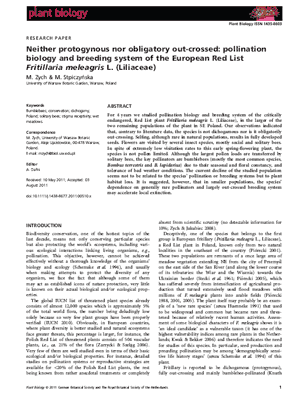NEWS 2011
Neither protogynous nor obligatory out-crossed: pollination biology and breeding system of the European Red List Fritillaria meleagris L. (Liliaceae)
M. Zych, M. Stpiczyńska
Plant Biology 14(2): 285-294 (2011)
doi:10.1111/j.1438-8677.2011.00510.x
University of Warsaw Botanic Garden, Warsaw, Poland
Abstract
For 4 years we studied pollination biology and breeding system of the critically endangered, Red List plant Fritillaria meleagris L. (Liliaceae), in the larger of the two remaining populations of the plant in SE Poland. Our observations indicated that, contrary to literature data, the species is not dichogamous nor is it obligatorily out-crossing. Selfing, although rare in natural populations, results in fully developed seeds. Flowers are visited by several insect species, mostly social and solitary bees. In spite of extremely low visitation rates to this early spring-flowering plant, the species is not pollen limited. Although the largest pollen loads are transferred by solitary bees, the key pollinators are bumblebees (mostly the most common species, Bombus terrestris and B. lapidarius) due to their seasonal and floral constancy, and tolerance of bad weather conditions. The current decline of the studied population seems not to be related to the species’ pollination or breeding systems but to plant habitat loss. It is suggested, however, that in smaller populations, the species’ dependence on generally rare pollinators and largely out-crossed breeding system may accelerate local extinction.

